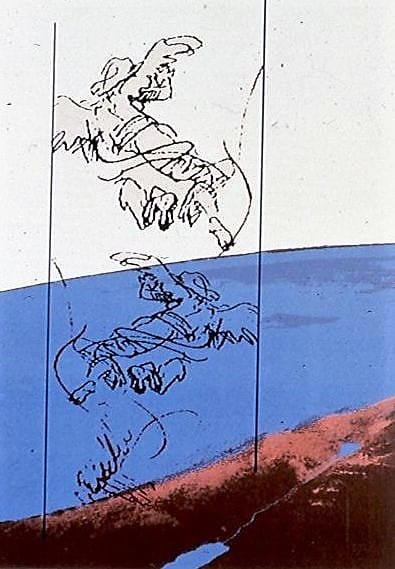Reboot your smartphone for spiritual seeing before your plane lands in Israel. Be prepared to see the Holy Land in fresh ways by focusing through a Bible lens. Transform your smartphone photos from tourist shots to images of spiritual power that convey biblical messages emerging from all you see.
Teaching how to see through a Bible lens is based upon my research on the interrelationships between digital culture, creative process, and biblical thought at MIT Center for Advanced Visual Studies, and as professor at Columbia University and universities in Israel. This article offers an overview of how to reboot you smartphone that is explored in depth in my book Through a Bible Lens: Biblical Insights for Smartphone Photography and Social Media.
SEEING SPIRITUAL SIGNIFICANCE

You can gain tools for looking beyond the surface of smartphone photos that are derived from an ancient method of biblical study called PaRDeS. The PaRDeS method for discerning deeper levels of significance in biblical texts can be valuable in mining meaning hidden beneath the surface of smartphone images.
The Hebrew word PaRDeS literally means grove or orchard. It is an acronym for four levels of looking beyond the biblical text. P’shat is the simple, literal meaning. Remez is a hint of symbolic significance. Drash is a conceptual interpretation. And Sod is spiritual and inspirational.
I will first demonstrate this four-step method by exploring the biblical text describing Jacob’s dream of angels ascending and descending on a ladder. Then, I will apply it to a photograph I created to illustrate human hands continuing the process of Creation after God finished His part.
LOOKING BEYOND A BIBLICAL TEXT
“He had a vision in a dream. A ladder was standing on the ground, its top reaching up towards heaven as Divine angels were going up and down on it.” (Genesis 28:12)
That a ladder is a ladder is P’shat.
That the ladder was spiral, like a spiral staircase, is the Remez. We arrive at the spiral shape of the ladder by noticing that the numerical value of the Hebrew words for “ladder” and for “spiral” are both 130. Creative play using numerical equivalents of Hebrew letters, a system called gematriah, can lead to fresh insights.
A more contemporary Remez links Jacob’s ladder to the DNA spiral ladder. The SPR root of SPiRal is found in many ancient and modern languages. The hand-written scroll of the Five Books of Moses is called SePheR Torah. SPR appears in SPiRitual and inSPiRation, two words most relevant for analyzing photographs taken through a Bible lens.
The ladder as a metaphor for Mount Sinai reaching up towards heaven from the ground below is Drash. Jacob’s dream was a prophetic vision of angels ascending the mountain to bring the Torah down to earth. The numerical value of “Sinai” is also 130.
The deepest significance of the ladder as symbolized in Sod is offered in the Zohar, a major work on the spiritual depths of biblical thought. It teaches that Jacob’s ladder is Jacob’s body with his head in the clouds dreaming of what can be while his feet rest on the ground where dreams are realized. Every human being has the potential to connect heaven and earth by making spiritual energy flow through him into the everyday world.
LOOKING BEYOND A PHOTOGRAPHIC IMAGE
I apply the PaRDeS method of looking beyond the surface to a photograph that I made for the Bible Blog Your Life project that I created in collaboration with my wife Miriam. See https://blibleblogyourlife.blogspot.com. The first blog post “Creation of the World at Our Doorstep” explores the opening chapter of the Bible, Bereshit/In the beginning (Genesis 1:1-6:8).

This photo is the last in a sequence of six images representing life forms in the biblical creation narrative. I photographed them all in and around my home: a cactus plant on our porch, red-leafed plants in front of our house, a cat hiding in the bushes between our door and a pet shop selling goldfish, and our dog Snowball. The sixth photo shows my wife’s fingers pressing cloves into a yellow citrus fruit.
P’shat (literal meaning) is an image of a woman’s fingers pressing cloves into a lemon.
Remez (symbolic significance) is that the fruit is not a lemon, but a citrus fruit called a citron, its scientific name is Citrus medica, and in Hebrew etrog. Jews hold an etrog together with a palm frond and branches of myrtle and willow leaves, on the holiday of Sukkot (Festival of Tabernacles) in accordance with the biblical mitzvah:
“And you shall take on the first day the fruit of beautiful trees, branches of palm trees and boughs of leafy trees and willows of the brook, and you shall rejoice before the Lord your God seven days!” (Leviticus 23:40).
Drash (conceptual interpretation) is that the four species symbolize four types of people that taken together form a community. The etrog has both a pleasant smell and taste, the date from a palm tree has no smell but a sweet taste, myrtle has a nice smell but no taste, and willow leaves have neither smell nor taste. Smell represents Bible study and the taste good deeds. The etrog symbolizes a person who both engages in studying biblical text and performing good deeds.
Sod (spiritual and inspirational meaning) is that my wife Miriam is recycling a mitzvah. After the holiday of Sukkot is over, the ritual role of the four species has ended. Instead of discarding the etrog, Miriam presses cloves into the entire etrog to preserve it for use in the havdalah ceremony marking ending of the Sabbath day. So that the extra soul we gain on the Sabbath to make it a sweet day does not make us faint as it suddenly departs, a pleasant fragrance is used to prolong it.
“God blessed the seventh day and hallowed it, for it was on this day that God ceased from all the work that He had created [for us] to do.” (Genesis 2:3)
A deeper meaning is Miriam becoming God’s partner in continuing God’s work. God created the etrog and cloves. She married these two Divine creations to create a new human creation that honors the Sabbath. Two of God’s botanical creations in the realm of space are joined by human creativity to honor God’s creation in the realm of time.
SEEING FOR THE FIRST TIME EVERYTIME
As a smartphone photographer, open your eyes to see all that is familiar from fresh perspectives. Stop looking at ordinary things passively. Actively look at them in ways that transform them into extraordinary images of the mundane. Create an imaginative sequence of photos of God as Divine light illuminating all aspects of everyday life.
In his review of my Through a Bible Lens book, Rabbi David Aaron, yeshiva dean in Jerusalem’s Old City and author of The Secret Life of God: Discovering the Divine within You, writes: “I am honored to see how Professor Alexenberg draws on my teachings and makes them come alive in the world of smartphones and social media. He provides a practical guide for photographing the splendor of God by opening your eyes in wonder in whatever place you find yourself. Seeing with eyes of wonder is seeing for the first time every time.”





